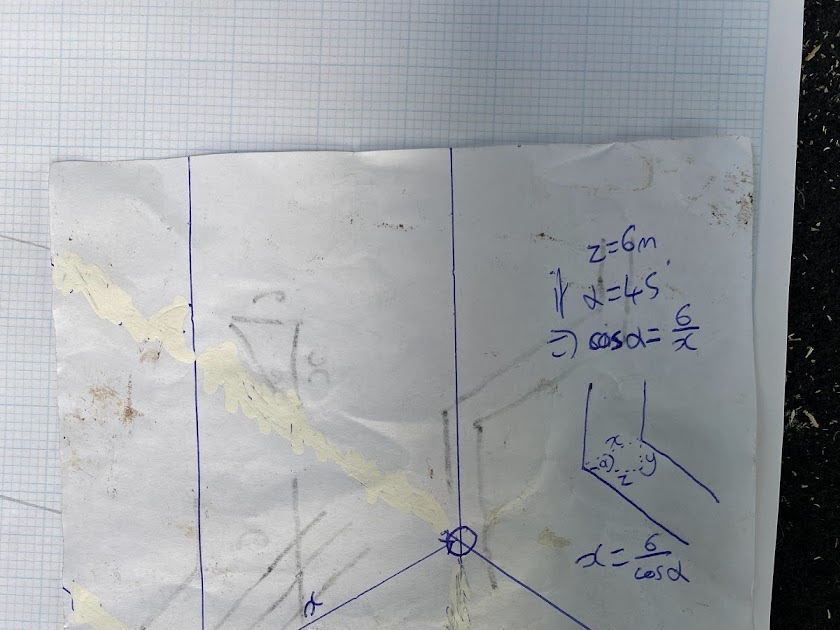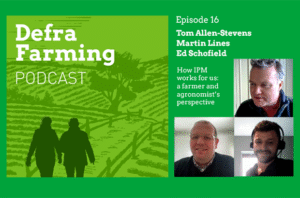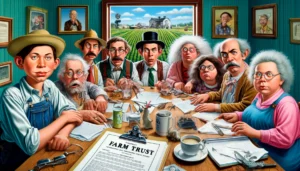June has seen some really exciting progress on the farm in Fobbing: the first fruition of plans that began a few years ago. I really feel that the farm is beginning to take shape into the form which I wish it to be, with nature being a primary focus and well & truly on display.
Somewhat unglamourously, most of these projects are infrastructure projects. In this instance, fencing. However, knowing that I didn’t have the capacity to get the fencing done ourselves, I hired in a contractor – Byron Stevens who had been recommended. Byron has a self-propelled post banger on tracks which moved surprisingly quickly, and I couldn’t believe the number of posts that we erected on the first day. Oh, to have professionals on the job! All in all it took six days to do a 3km stretch of fencing. But we still have to come back to install the top barbed wire, and a lot of gates!
 |
| GCSE trig to figure out the angles! |
 |
| Byron with his self-propelled post banger |
 |
| Getting stuck into the undergrowth! |
The fencing has been erected for a number of reasons. The first was re-fencing our meadow. Too many times cows have managed to get into the graveyard of the church, and I felt it was time to put a stop to that. I also have made the decision to breed bulls on the farm, in order to sell them as breeding bulls. This might sound simple, but requires sensible infrastructure, since the young bulls are fertile from five months, and it’s not ideal if they start inseminating their sisters. So we have also fenced two meadows as bull fields (which can be subdivided into paddocks). These fields are large enough to manage my bull calves, plus enable the bull to stay outside all year round rather than having to pop him in a shed when he isn’t doing the business.
 |
| Tensioning the wire. |
 |
| Tensioning and lining up the cut wire. |
 |
| Crimping the tensioned wire together. |
Finally in some regards the most important aspect of the fencing was to fence the footpath. The last thing I wanted to do was to make a fenced footpath pinched. Legally they are only required to be 1.5m wide, but I have made mine 6m. This has become a necessity both for the protection of people’s pets, plus the protection of my livestock. The fencing means that contaminated dogs should not be able to poop in with my cows, so shouldn’t infect them, and also that dogs won’t be able to go near the cows to be infected with neospora themselves (via contaminated birth material). That isn’t to say that dogs can be let off to roam free on my fenced footpath though! Whilst on my farm, dogs must remain on their lead at all times, and their mess always picked up and taken away to be disposed of properly. The other benefit here is obviously the wildlife on my farm, which the fence also protects from being disturbed.
There are a couple of other plusses from a management perspective for me on the farm. The first of which is that the footpath now acts as a very useful dedicated farm track, keeping machinery off the road as much as possible. And also as a race for the cows to run them from one area of the farm to another, or indeed to run them to a dedicated handling facility. Whilst this will happen infrequently, it will still be a boon, and should mean that I don’t have to hook on the cattle trailer so often when needing to shift cows.
The thing that has got me most delighted about this fencing is that I have finally begun demarking the wild seam through the middle of the farm. I have spoken of this pioneering project a number of times on social media, and I really believe it to be the most innovative thing I have done on the farm.
 |
| Vaccinating for lepto. |
The aim of the seam is to act like a nature superhighway, carving through the middle of the farm, interconnecting every field and acting as a permanent safe haven for wildlife and fauna to reside. Essentially I am conducting a managed approach to wilding some of my landscape, utilising livestock as an important tool in dynamic destruction, allowing new life to come in. Traditionally, fields are always separated by ditches or hedges. And regularly those are areas that are fenced off to livestock. However, these are also the areas that are ecologically most interesting, and where dynamic changes can build new habitats for more ecology and nature to enter. In terms of animal utilisation, I only have cows at the moment. They are possibly the most important animal to start with, but I’d love to introduce pigs and perhaps horses in the future. Currently this is only the very start of this project and I have fingers crossed for some funding which will enable me to spur the seam out into the SSSI (site of special scientific interest, which Natural England has a lot of say over) between the sea walls by the creek. The funding should also help with some supplemental planting to increase plant diversity on the farm, and the creation of ephemeral ponds (i.e. ones which might dry out for parts of the year).
With the wild seam now open for business, I got to run my breeding herd through it for the first time. I took the opportunity before they entered to vaccinate them for leptospirosis, a water borne disease I know we have on the farm, since they would have more opportunity than usual to drink from ditches and ponds. The change in the landscape in this first period of grazing was quite simply astounding, and rather emotional. With cattle able to graze amongst copses and walk in the reeds by the pond for the first time ever. Watching them browsing on leaves, rubbing on all the trees, creating new hollow-ways was just magical. Genuinely acting as a tool for nature restoration.
 |
| Cows doing their thing in the wild seam. |
 |
| An opportunity to get out of the sun under this copse that was previous fenced off. Plus the clearance around the base of the trees will open up that environment to lots of other creatures. |
It felt weird to have to take the cows off this. But it was important to not graze the pasture hard, and to ensure that lots of the land remained undisturbed. I would like to have a bunch in for a short period in the Winter though, just to ensure some destruction in wet conditions occurs too.
The second Sunday of the month was Open Farm Sunday 2022, and as per usual I opened my farm up for an afternoon farm walk. Having been spoiled by a glut of over a hundred attendees last year, all desperate to have something to do during covid, I was initially a little disappointed by a turn-out of thirty. However, it made for a lovely sized walk, with everyone able to ask questions if they wished and see and hear what was going on on the farm.
 |
| Mia and I doing our thing: talking cows. |
The best bit of the afternoon happened to be the dung beetle safari (a last-minute addition I chose to add in at the midpoint of the walk to instil a short break). Mia packed some vet gloves, and at a reasonably dungy part of a recently grazed paddock we handed these out to those keen to get their hands in poo. It worked out excellently, amongst the kids but also a number of adults too (my best mate’s other half loving getting stuck in…to his disgust!). It made me feel better and somewhat less odd to know that it isn’t just me that gets so enthralled by these things.
 |
| Hunting in poop. |
 |
| At least they showed up! |
At the end of the month, and related to this year’s big fencing project, came the installation of two cattle grids. These grids enable cars to drive through fields of livestock without needing to open a gate – the animals won’t cross the grid. I was very lucky to have the help of my brother-in-law, Jamie, who is a property developer and builder. It felt quite nerve-wracking cutting the tarmac track for the first time, but over the course of two days, Paul, Jamie and I installed two of these grids. They look super smart, make just the right noise when you drive over them, and they really make the place feel like a mixed farm, with livestock and cropping. I have loved cattle grids since I was a kid, so being able to legitimately put a couple in was even more thrilling. I can’t wait to have cows in these paddocks now so that we can drive through the field with the cows, rather than them being the other side of the fence. I just wonder what Mum will say when they start leaving lick and snot marks all over her car…
 |
| Nerve-wracking when you are pulling up perfectly good tarmac! |
 |
| Stage one: a hole. |
 |
| My brother-in-law gamely lending a hand (whilst learning the difference between house building and farm building!) |
 |
| The concrete base being lowered onto the levelled and compacted hardcore base. |
 |
| First grid completed. |
 |
| The second grid went much quicker. |
June also saw the return of Groundswell – the two-day regenerative agriculture festival / show / conference, run by the Cherry family in Hertfordshire. The first Groundswell back in 2017 had 400 attendees, so it is a little bonkers that this year around 5,500 folk visited! On the whole, I went to the show for networking purposes and to let my hair down. New ideas are great, but I have enough to be getting on with on the farm for a fair few years yet! Consequently, I didn’t go to many of the talks that were put on, but managed to catch up with a lot of good friends, as well as meet a couple of Instagram friends for the first time.
I was somewhat in attendance in my capacity as producer on the regen-
farming doc, Six Inches of Soil. The whole team was there, so it was great to catch up with them. One highlight for me was having the opportunity to interview George Monbiot for the film. George is naturally a divisive figure, and it is doubtless that his views, as construed in his new book, Regenesis, are a touch utopic and heavy handed, but he makes some good points. Being the first interview I had ever conducted I was naturally very nervous, but given that the crew didn’t give me any direction I hope I did a good job!
 |
| The Six Inches of Soil team. |
 |
| My opportunity to interview the controversial Monbiot for the film. |
Also for the film, I hosted an open discussion for forty minutes with the three new entrant farmers starring in the film: Anna Jackson (mixed
farming), Ben Thomas (beef) and Adrienne Gordon (horticulture). Another first for me on camera, but it was fun, and the three farmers were really engaging and interesting to speak with. The film is moving on a pace now, with the intention of being released at Groundswell next year. I can’t wait to see how it turns out.
 |
| Anna, Ben, Adrienne and I for the filmed open discussion. |
The best bit of Groundswell from my point of view actually occurred on the evening of the first day. Mia and I were camping, and on returning to the tent at 9pm to don some warmer clothes, I grabbed Nyx (Mia’s spaniel) into the tent and told Mia to wait. She assumed I was doing something silly with the dog. However, two minutes later I let Mia in for her to be greeted by a bandana-wearing Nyx. It took Mia a minute to realise that this wasn’t just a one-year anniversary present, but rather had the following printed on it: “Mia, will you marry me?”. I then produced from my pocket not a ring, but a rubber-duck-frog holding a sign emblazoned “Engagement ring frog” (Mia collects rubber ducks, so it isn’t entirely random). Thankfully she said yes. And we returned to the party to celebrate with champagne, good
farming friends and much revelry. We have now picked an engagement ring which is currently being made.
 |
| I’m not one to do things conventionally… |
 |
| The day after the night before: engaged! |
As I type this at the start of July, harvest is fast approaching and I am no where near ready for it. I expect by the end of this month we will have already cut something. So we had better get busy and get the stores cleaned out!





























